I’m a street food enthusiast through and through. It’s the culinary aspect I eagerly anticipate most when traveling to a new place.
During our month-long exploration of Colombia, while I appreciated the refined dining experiences like Leo in Bogota, nothing excited me more than discovering authentic Colombian Street Food.
From the iconic arepas de huevo in Cartagena to the Medellín’s flavorful perros calientes, if you’re planning a trip to Colombia and share my passion for street food, this guide to the best Colombian street foods is your essential companion.
Essential Colombian Street Food Guide
For an immersive experience into Colombian gastronomy, consider enhancing your trip by joining a local food tour or participating in a Colombian cooking class. These experiences offer deeper insights into the country’s rich culinary heritage.
Explore Colombian Food Culture
Dive into the World of Colombian Street Food
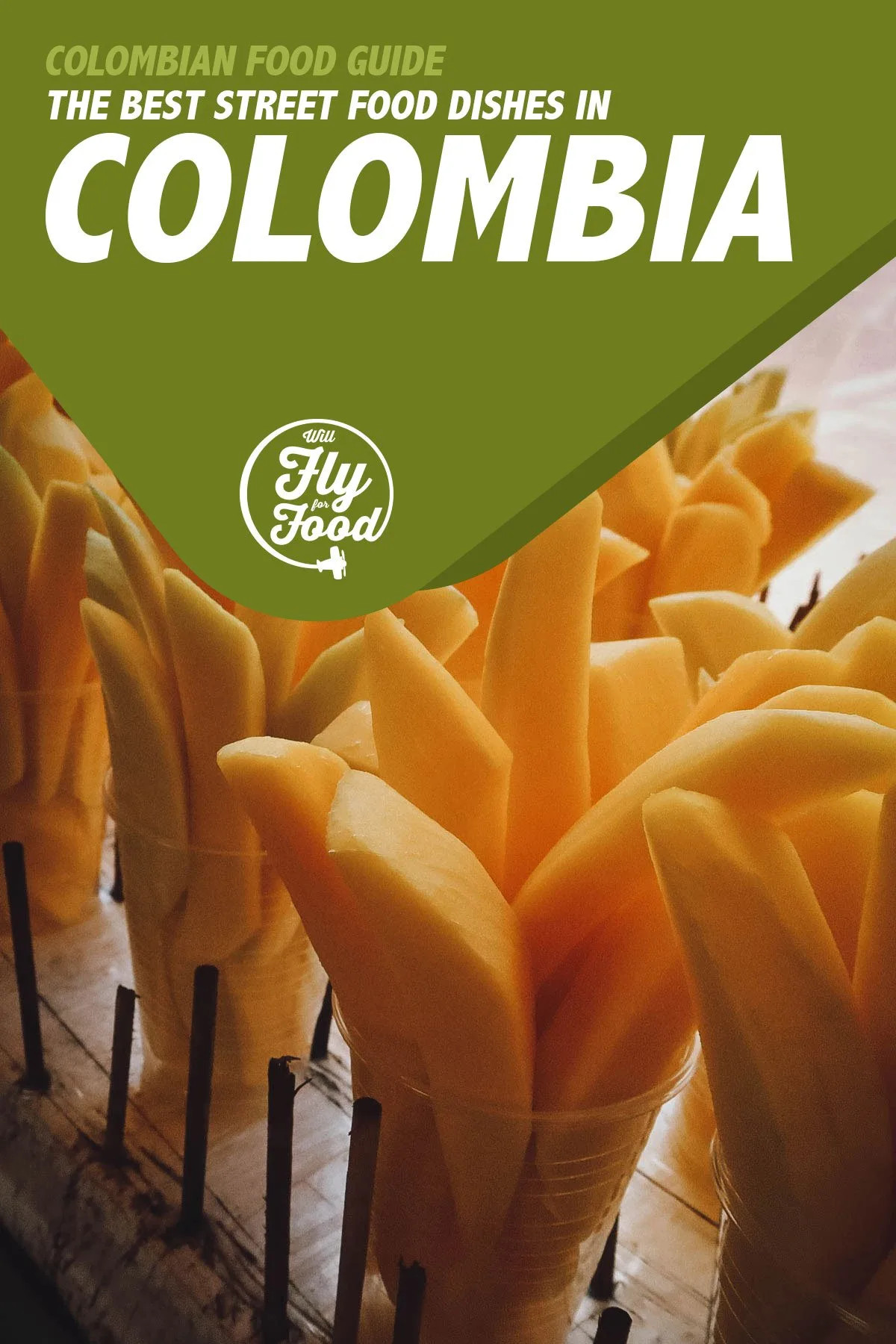 A vibrant display of Colombian mango biche from a street vendor in Cartagena, showcasing the fresh and tangy street snack.
A vibrant display of Colombian mango biche from a street vendor in Cartagena, showcasing the fresh and tangy street snack.
Unveiling the Most Delicious Street Foods Colombia Offers
1. Arepas: The Cornerstone of Colombian Cuisine
Arepas are arguably the most fundamental food in Colombian cuisine. These corn cakes, crafted from corn dough, are a staple at virtually every meal across Colombia. Order any traditional Colombian dish, and you’re likely to find arepas served as a side, among other accompaniments.
While arepas are a common sight at breakfast, lunch, and dinner tables, they also stand out as a premier Colombian street food. Here are a couple of my favorite arepa variations:
Arepas de Huevo: Cartagena’s Street Food Gem
Upon learning of our Cartagena visit, a Colombian friend insisted, “You absolutely must try arepa de huevo.” This stuffed arepa is a signature street food in Cartagena, beloved along Colombia’s Caribbean coast.
Arepas de huevo are made by frying a corn cake filled with ground meat and a raw egg. While typically containing both, you can opt for a version with just egg, known as “arepa solo huevo” (as pictured below).
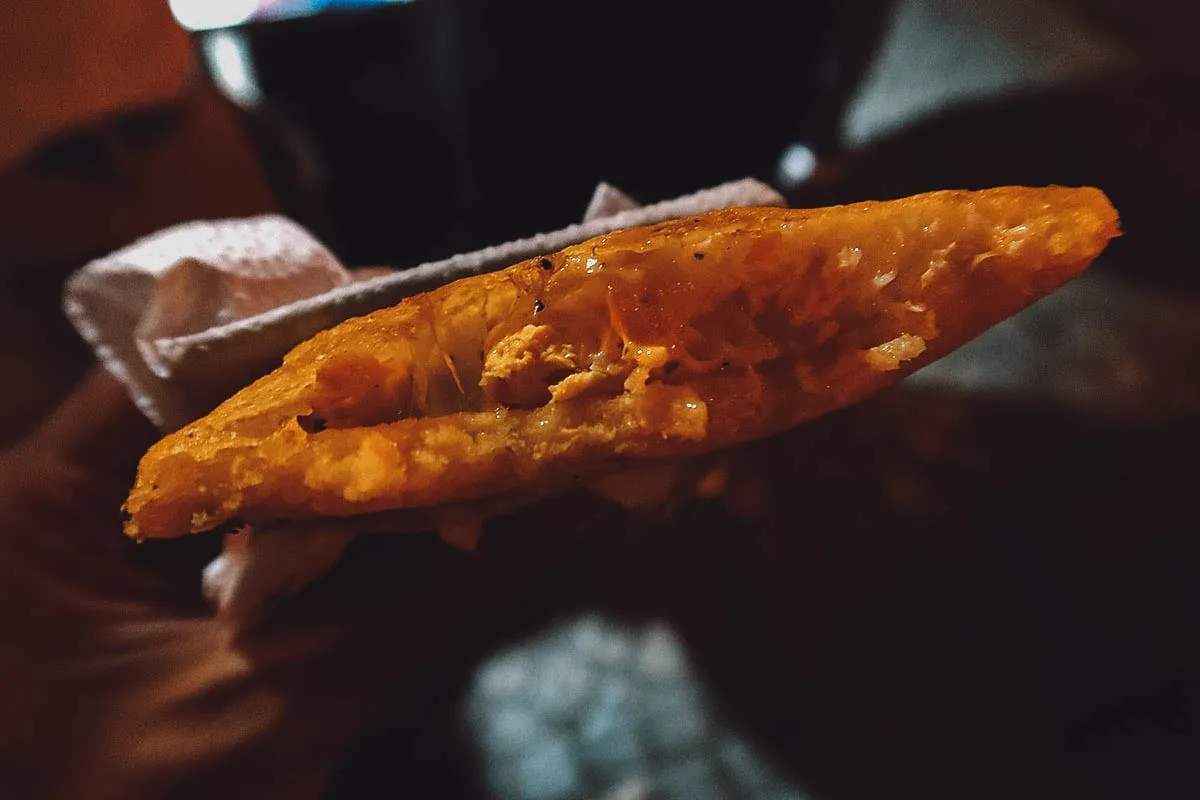 A close-up of a Colombian arepa solo huevo, highlighting the golden-brown fried corn cake with a visible egg filling, a simple yet satisfying street food.
A close-up of a Colombian arepa solo huevo, highlighting the golden-brown fried corn cake with a visible egg filling, a simple yet satisfying street food.
When filled with both ground meat and egg, the arepa de huevo becomes a hearty and flavorful snack. Widely available from street vendors in Cartagena, this savory pocket of meat and egg quickly became one of my top Colombian street food discoveries. It’s a must-try!
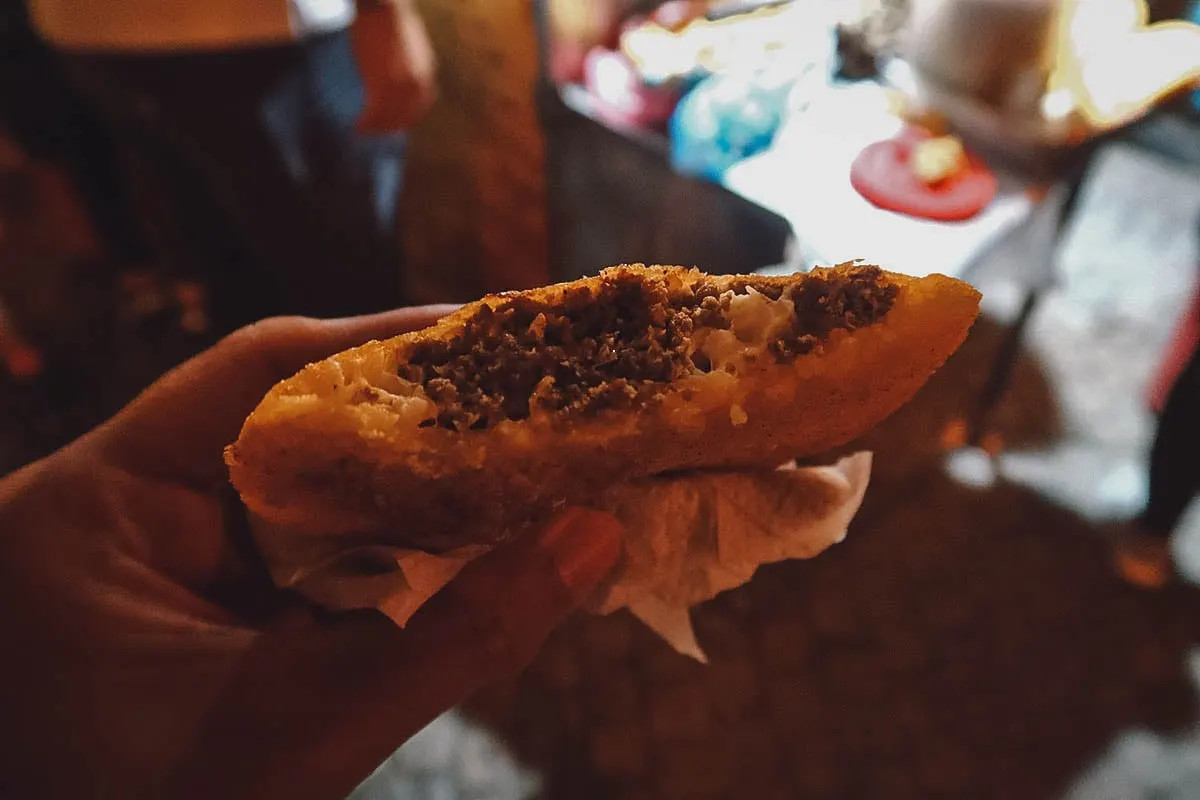 A delectable Colombian arepa de huevo, showcasing the crispy exterior and rich filling of ground meat and egg, a popular street food in Cartagena.
A delectable Colombian arepa de huevo, showcasing the crispy exterior and rich filling of ground meat and egg, a popular street food in Cartagena.
Arepas de Queso: Cheesy Delight on the Streets
Equally popular are arepas de queso, cheese-filled arepas. These are a favored street food or breakfast option, consisting of arepas enriched with butter and queso costeño, a mild, salty Colombian white cheese. Think of them as Colombia’s take on a grilled cheese, offering a comforting and cheesy bite.
Though I didn’t sample it, I noticed arepas de queso sometimes topped with sweetened condensed milk, likely a sweeter breakfast variation.
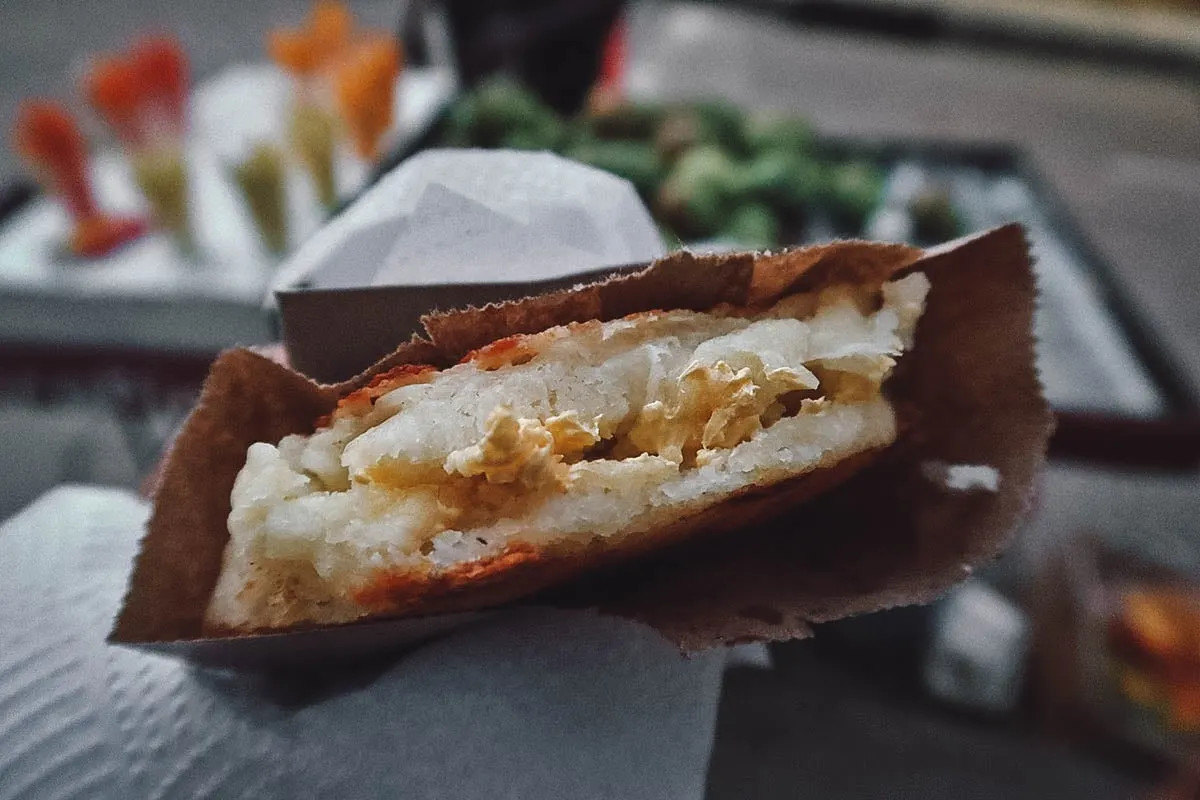 A tempting Colombian arepa de queso, filled with melting cheese and grilled to perfection, a simple yet satisfying street food snack.
A tempting Colombian arepa de queso, filled with melting cheese and grilled to perfection, a simple yet satisfying street food snack.
2. Empanadas: A Globally Loved Savory Pastry
If you’re familiar with Hispanic cultures, you’ve probably encountered empanadas. Originating from Spain, these ubiquitous street food pastries are sold across Latin America, including Venezuela, Argentina, Mexico, and Chile. Spanish influence has even made them a popular snack in the Philippines.
Empanadas vary widely, but in Colombia, they’re typically made from corn flour and almost always deep-fried to achieve a perfect crispiness. Fillings range from ground meat and shredded chicken to potatoes, cheese, and vegetables, catering to diverse tastes.
No matter where you are in Colombia, empanadas are a readily available and satisfying snack. Just stroll through any bustling area, and you’ll soon spot a street vendor offering these delicious, golden-brown pockets of flavor.
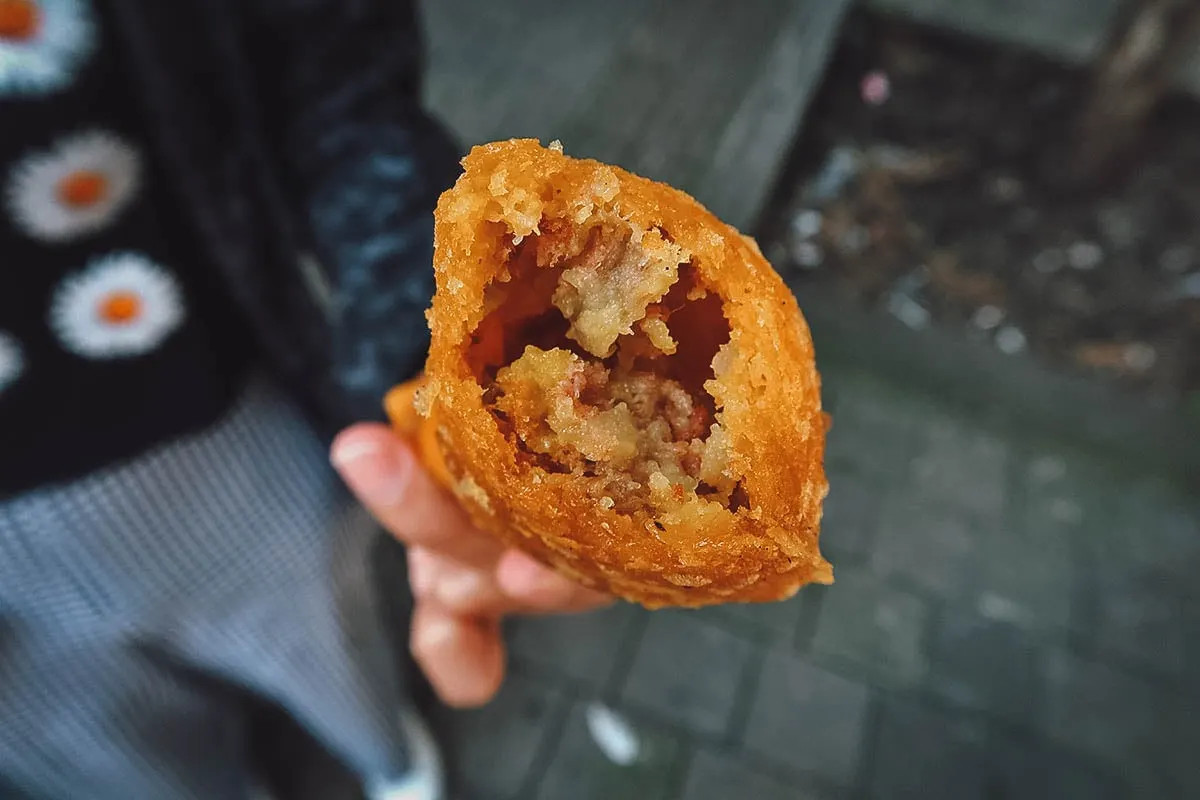 A golden-brown Colombian empanada, showcasing its crispy, deep-fried corn exterior and savory filling, a widely enjoyed street food snack.
A golden-brown Colombian empanada, showcasing its crispy, deep-fried corn exterior and savory filling, a widely enjoyed street food snack.
3. Carimañolas: Yuca’s Unique Street Food Offering
Carimañolas, popular in both Colombia and Panama, are another must-try Colombian street food snack. Similar to empanadas, they distinguish themselves with a torpedo shape and dough made from mashed yuca (cassava), resulting in a notably softer texture.
Like their empanada cousins, carimañolas can be filled with various ingredients, most commonly ground meat, shredded chicken, or cheese, offering a delightful textural and flavor experience.
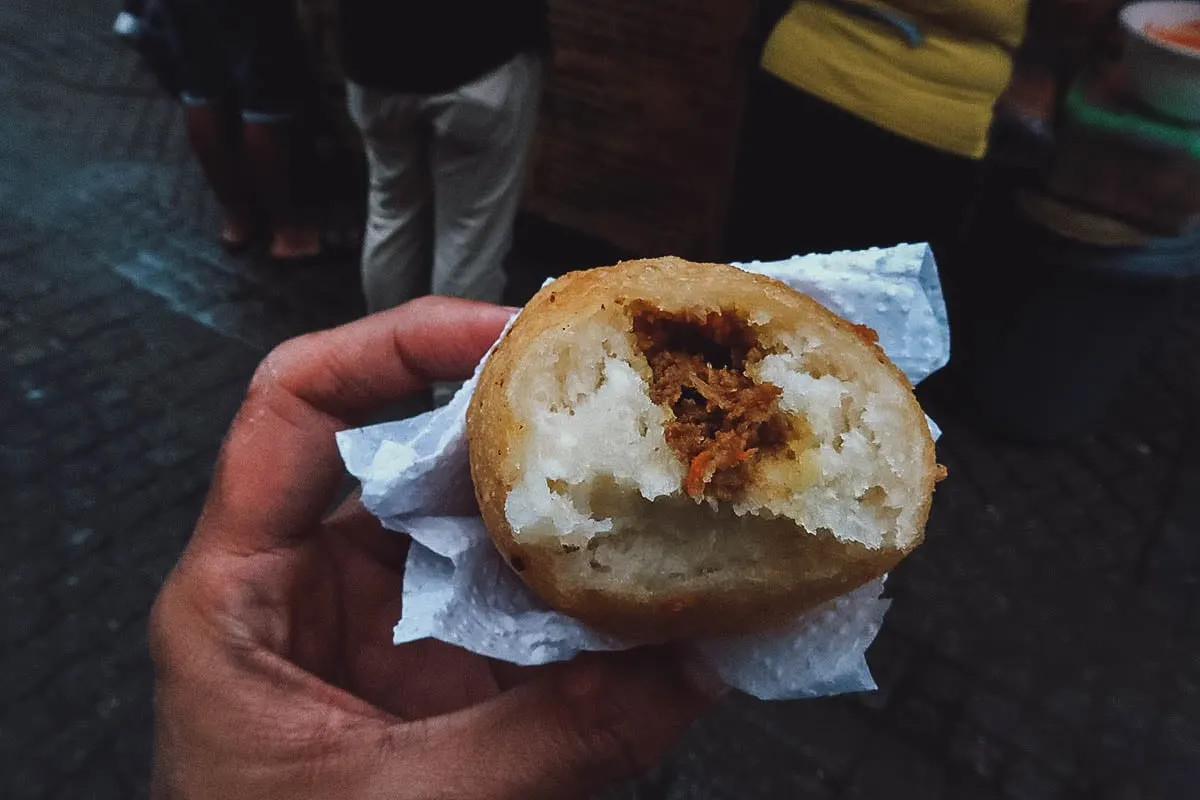 A Colombian carimañola, highlighting its distinctive torpedo shape and smooth yuca dough, filled with savory ingredients, a unique street food treat.
A Colombian carimañola, highlighting its distinctive torpedo shape and smooth yuca dough, filled with savory ingredients, a unique street food treat.
4. Papas con Huevo y Carne: Fried Potato Perfection
If arepas de huevo claimed my afternoons in Cartagena, papas con huevo y carne closely followed as a favorite snack. Many street vendors offer both, making it easy to follow up a delicious arepa de huevo with these hearty fried potato balls.
Papas con huevo y carne, as the name suggests, are deep-fried mashed potato balls filled with eggs and seasoned ground meat. This street food showcases a recurring theme in Colombian cuisine: savory fillings encased in fried dough or potato.
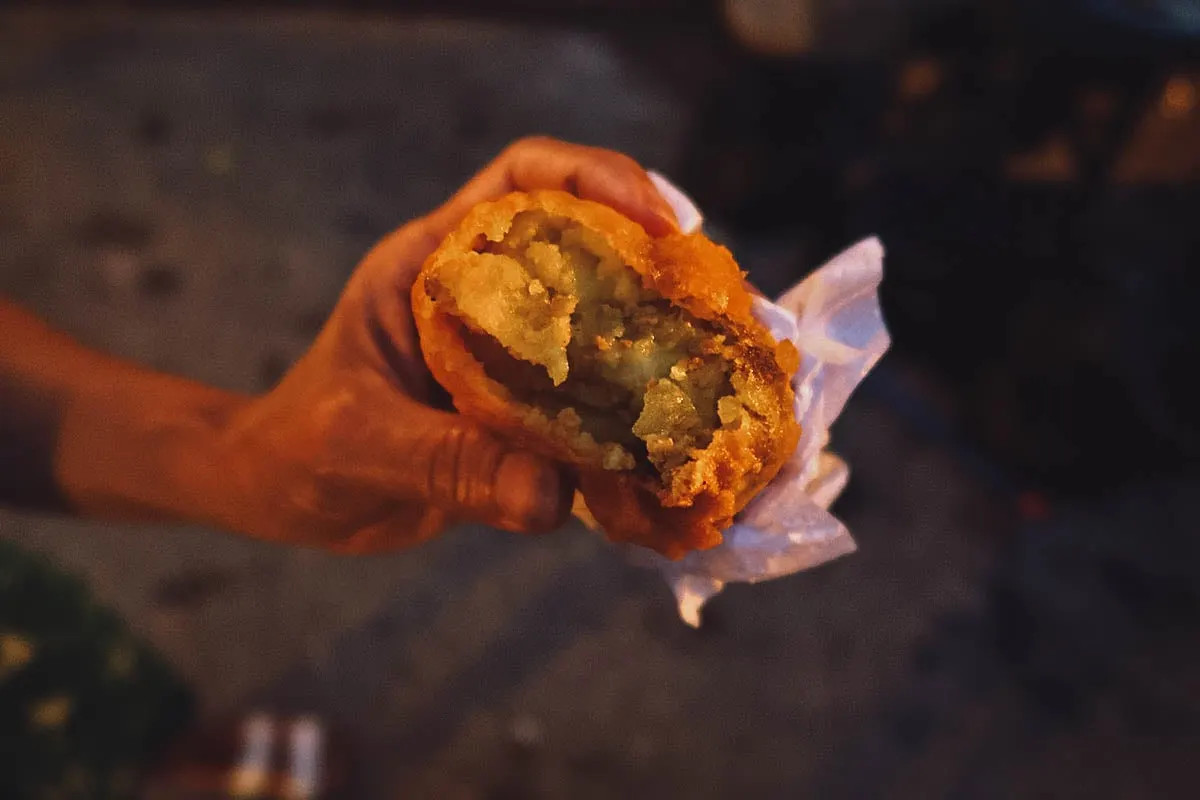 Colombian papa con huevo y carne, featuring golden-fried mashed potato balls filled with egg and meat, a satisfying and savory street food snack.
Colombian papa con huevo y carne, featuring golden-fried mashed potato balls filled with egg and meat, a satisfying and savory street food snack.
5. Tamales Tolimenses: A Taste of the Andes
Tamales are a staple across South and Latin America, and the Philippines. Colombia boasts its own delicious versions, with Tamales Tolimenses originating from the Tolima Department in the Andean region.
Tamales tolimenses are generously filled with chicken, pork ribs, potatoes, peas, carrots, boiled eggs, and rice, all wrapped in plantain leaves and steamed. They’re a popular breakfast in Bogota, often enjoyed with chocolate santafereño, a hot chocolate with queso campesino.
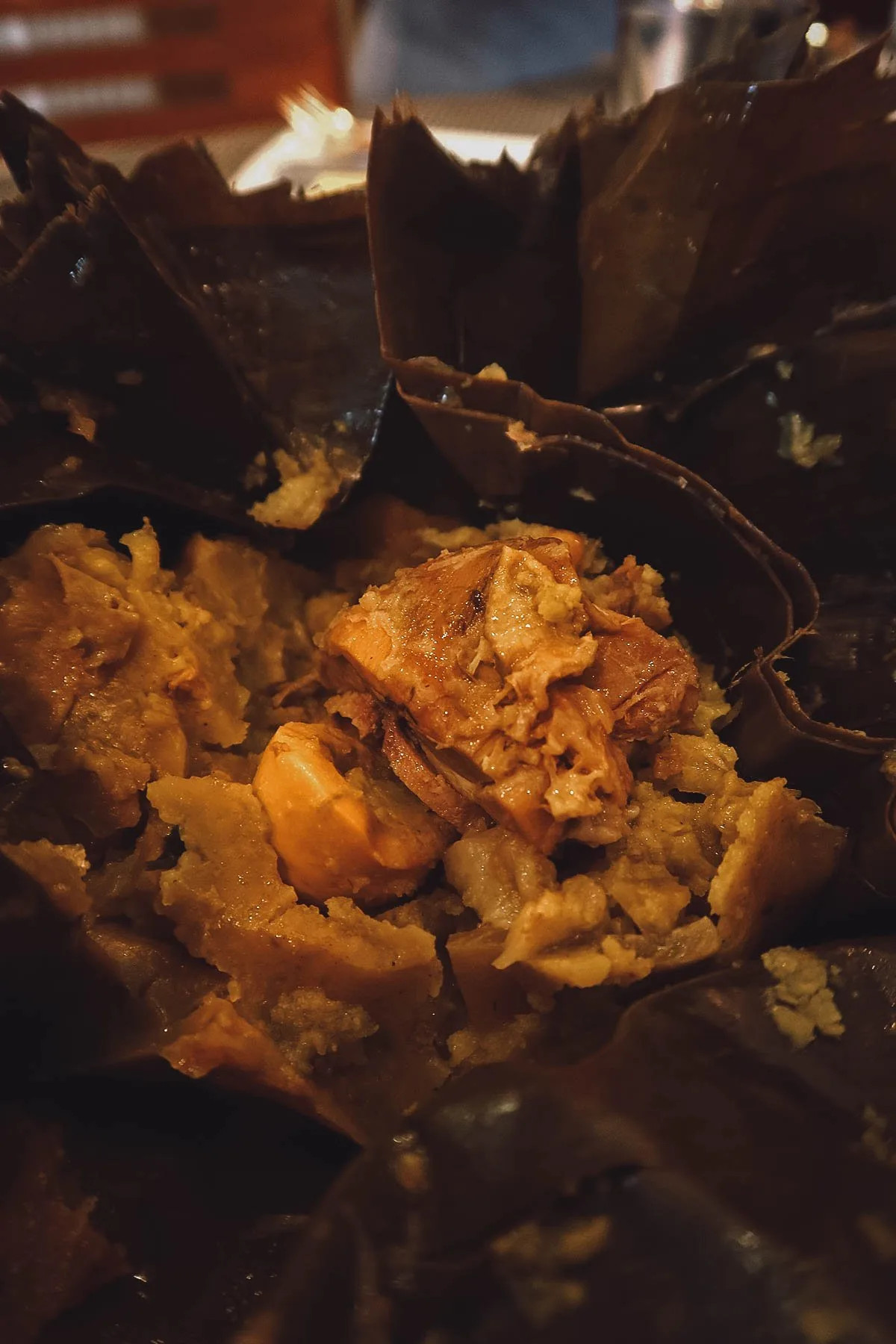 A hearty Colombian tamal tolimense, unwrapped to reveal a rich mixture of rice, meats, and vegetables steamed in plantain leaves, a flavorful and traditional dish.
A hearty Colombian tamal tolimense, unwrapped to reveal a rich mixture of rice, meats, and vegetables steamed in plantain leaves, a flavorful and traditional dish.
6. Bollo de Mazorca con Queso: Sweet Corn Delight
If you enjoy tamales, bollos de mazorca are another must-try. These sweet corn rolls are made from mashed or pureed fresh corn, wrapped in corn husks, and steamed. Unlike tamales, which use nixtamalized corn, bollos de mazorca highlight the fresh sweetness of corn.
The version “bollos de mazorca con queso” is served with cubes of white Colombian cheese, adding a salty contrast to the sweet corn.
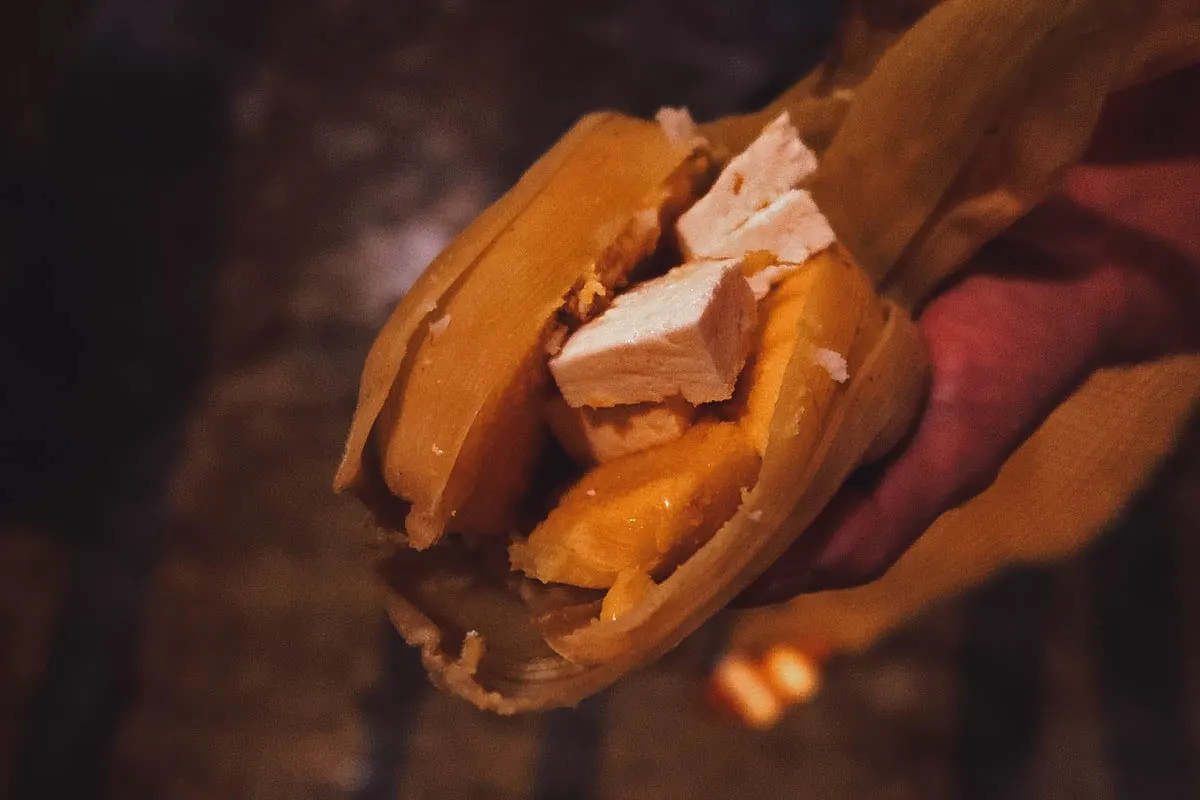 Colombian bollo de mazorca con queso, showcasing sweet corn rolls paired with white cheese cubes, a simple yet delightful street food combination.
Colombian bollo de mazorca con queso, showcasing sweet corn rolls paired with white cheese cubes, a simple yet delightful street food combination.
7. Colombian Cheese Bread: A Trio of Baked Goodness
In Cartagena, my mornings often started with Colombian cheese bread and coffee. Traditional bakeries throughout Colombia offer various cheese breads, with these three being the most prevalent:
Almojábana: The Quintessential Cheese Bread
Almojábana is perhaps the most recognized Colombian cheese bread. Made with cornmeal and cuajada cheese, a fresh cheese from unpasteurized milk, it offers a unique tangy and cheesy flavor.
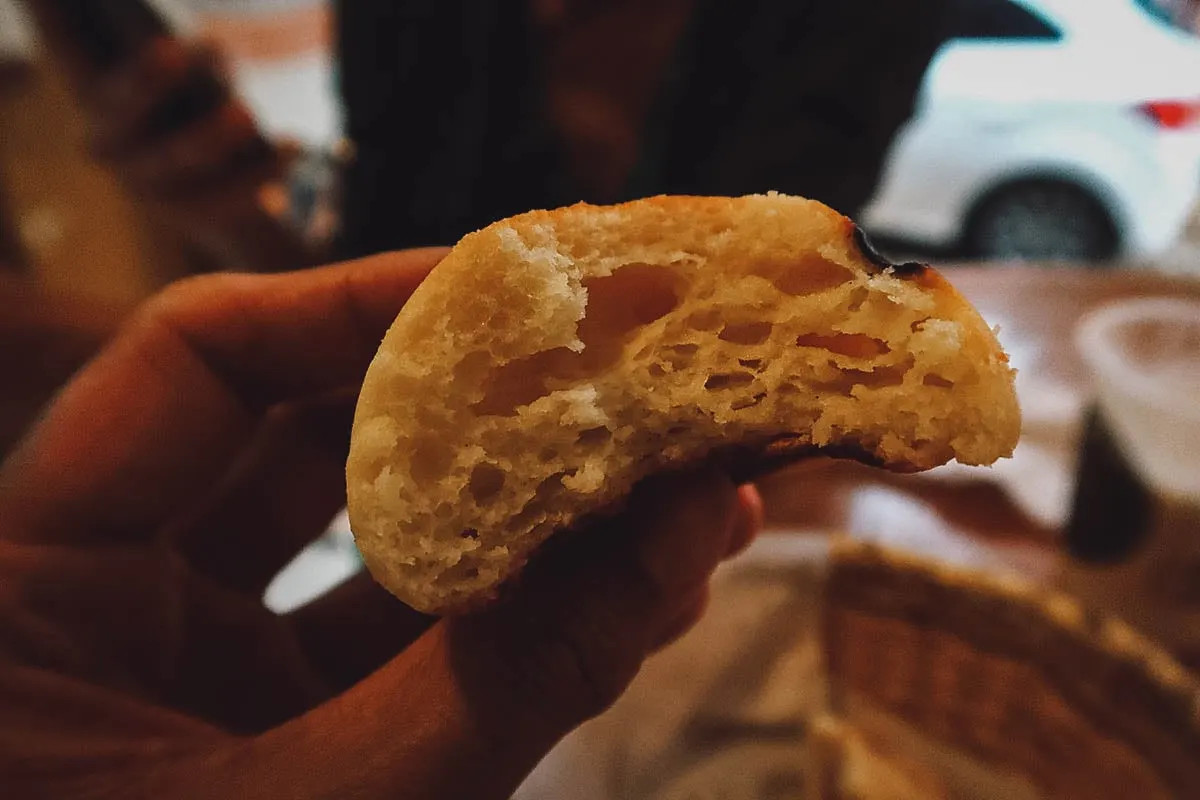 A Colombian almojabana, presenting a round cheese bread with a slightly browned top, made with cornmeal and fresh cheese, a popular breakfast item.
A Colombian almojabana, presenting a round cheese bread with a slightly browned top, made with cornmeal and fresh cheese, a popular breakfast item.
Pandebono: Chewy and Irresistible
Pandebono is similar to almojábana but incorporates yuca flour, corn flour, and costeño cheese. I personally prefer pandebono for its springier texture, thanks to the yuca flour.
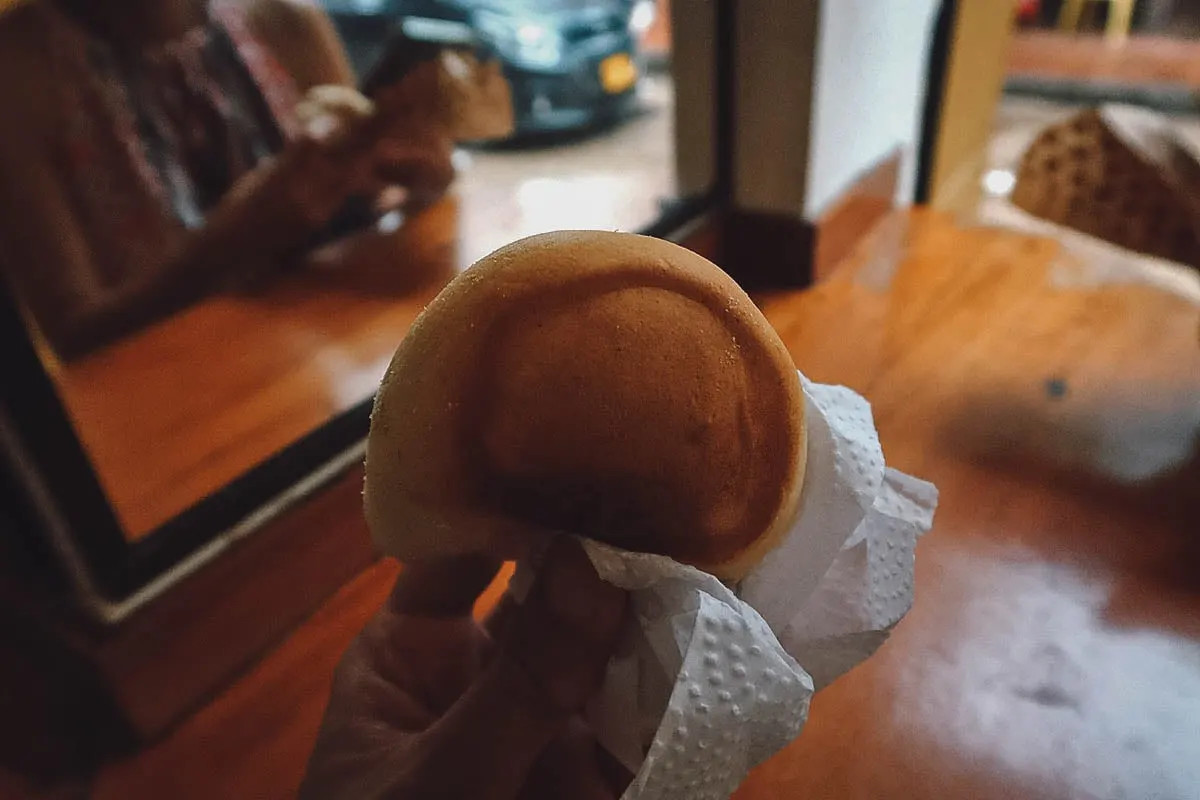 A Colombian pandebono, displaying a cluster of small, round cheese breads with a slightly golden crust, known for their chewy texture and cheesy flavor.
A Colombian pandebono, displaying a cluster of small, round cheese breads with a slightly golden crust, known for their chewy texture and cheesy flavor.
Pandeyuca: Airy and Unique
Pandeyuca, disregarding its irregular shape, shares similarities with pandebono, but is made solely with yuca flour. This subtle difference creates a bread roll that’s significantly airier and drier than pandebono.
Pandeyuca’s unique texture, almost hollow inside, makes it the most intriguing of the three for me.
8. Buñuelos: Sweet Fried Dough Balls
Buñuelos, another Spanish-origin street food, appear in various forms across Latin America. They can be flat, round, ring-shaped, or rosette-shaped, depending on regional variations.
Colombian buñuelos are typically small balls or ovals made with corn starch and yuca flour. Usually filled with curd white cheese and deep-fried, they can also include fillings like guava jam, arequipe (dulce de leche), or chocolate for a sweeter twist.
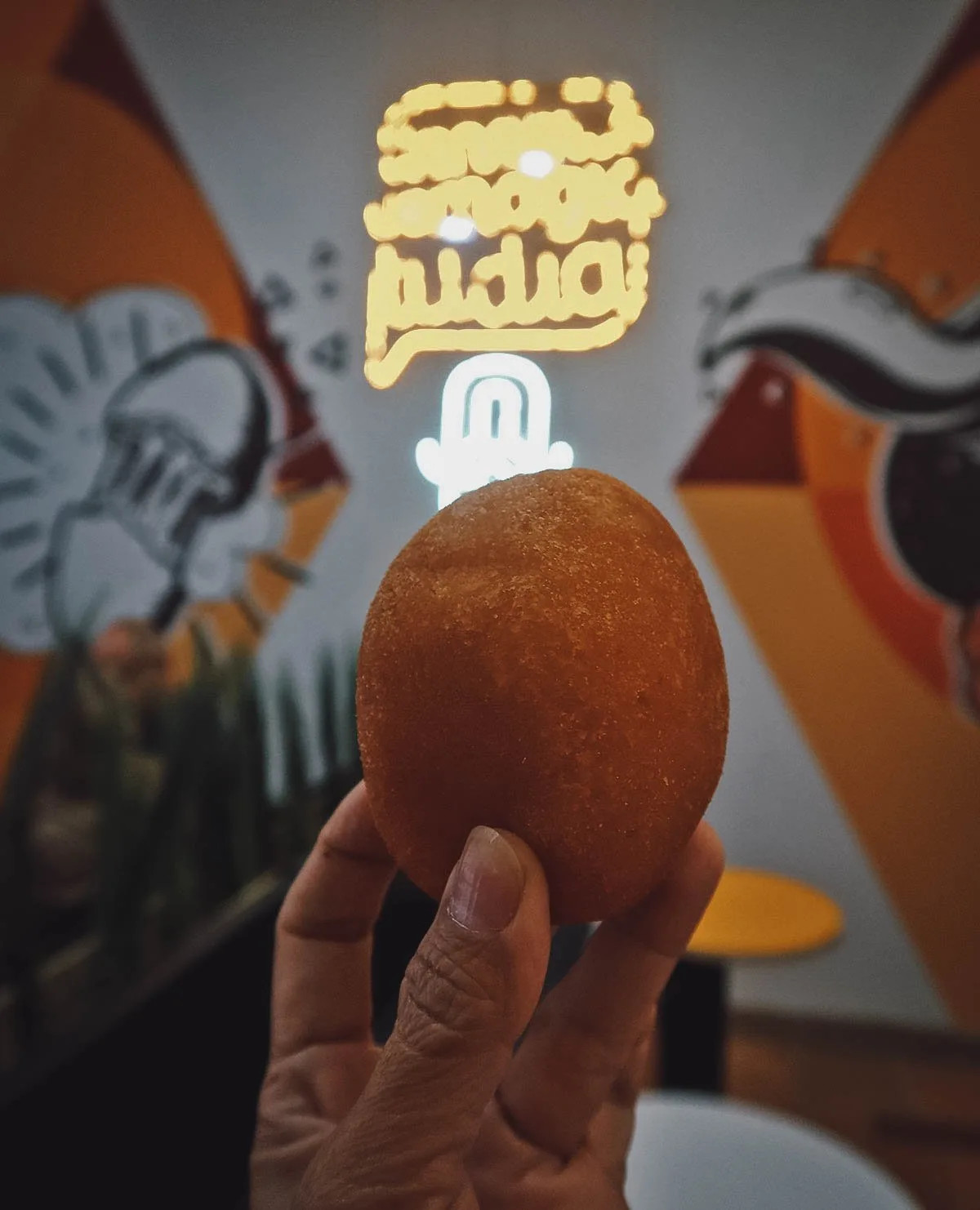 Colombian bunuelo, featuring golden-fried dough balls, a popular sweet treat often enjoyed during holidays or as a snack.
Colombian bunuelo, featuring golden-fried dough balls, a popular sweet treat often enjoyed during holidays or as a snack.
9. Dedo de Queso: Simple Cheese Sticks
Dedos de queso, meaning “cheese fingers,” are a common Colombian street food. These cheese sticks are made with local white cheese, offering a simple yet satisfying snack.
Available in various sizes, from larger dedos de queso to smaller deditos de queso (“little fingers”), they’re a frequent sight at Colombian street food stalls.
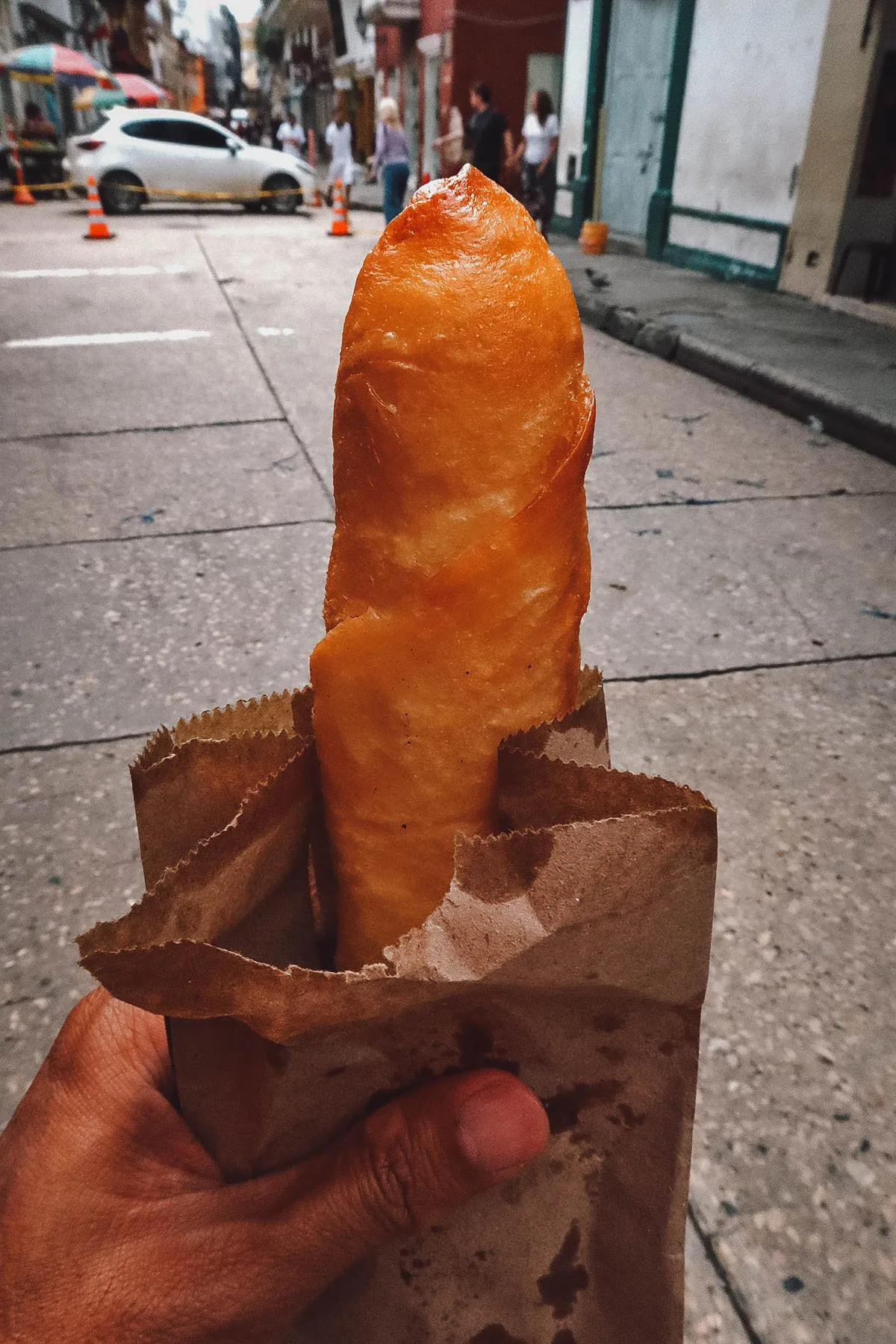 Colombian dedo de queso, presenting a cheese stick made with white cheese and fried to a golden brown, a simple and popular street food snack.
Colombian dedo de queso, presenting a cheese stick made with white cheese and fried to a golden brown, a simple and popular street food snack.
10. Pinchos / Chuzos: Skewered Meat Delights
Meat on a stick? Absolutely!
Pinchos or chuzos are Colombian meat skewers, grilled over charcoal. These popular street foods can feature various meats like chicken, beef, pork, or sausages, offering a smoky and savory experience.
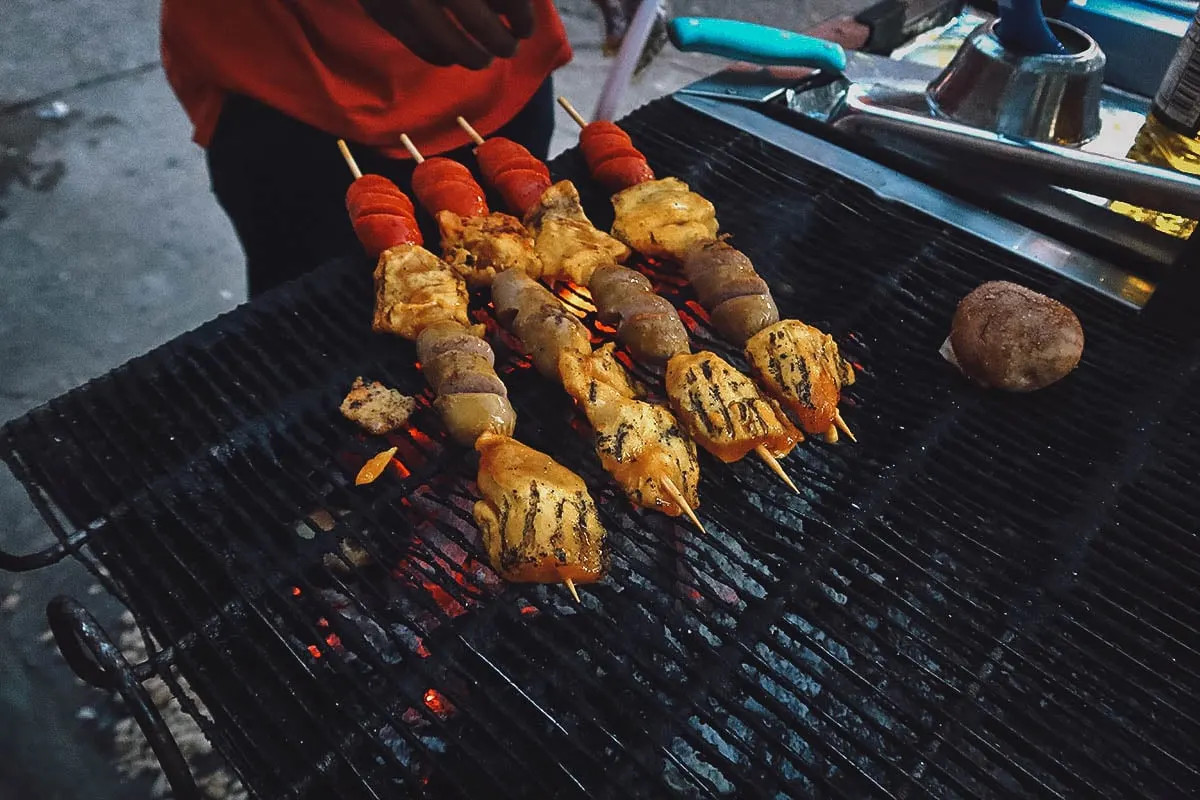 Colombian pinchos, showcasing grilled meat skewers with visible char marks, a flavorful street food option made with various types of meat.
Colombian pinchos, showcasing grilled meat skewers with visible char marks, a flavorful street food option made with various types of meat.
This generous pincho from a Cartagena street vendor was served with sauces and a hot potato, exemplifying the hearty and flavorful nature of Colombian street food.
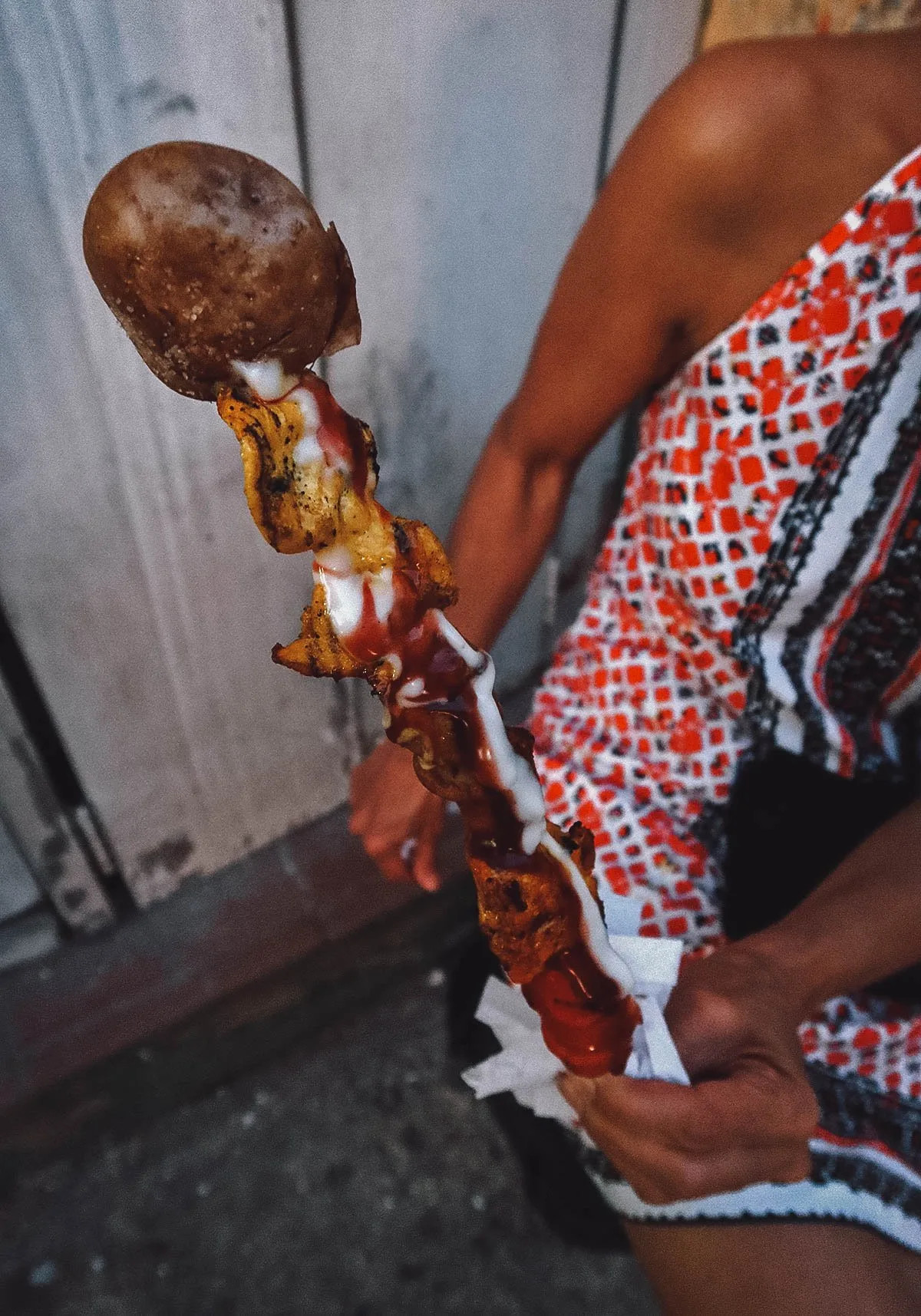 A close-up of Colombian pinchos, highlighting the generous sauces drizzled over the grilled meats, a flavorful and customizable street food skewer.
A close-up of Colombian pinchos, highlighting the generous sauces drizzled over the grilled meats, a flavorful and customizable street food skewer.
11. Salchipapas: A Mountain of Fries and Sausages
Salchipapa, a portmanteau of “salchicha” (sausage) and “papa” (potato), perfectly describes this street food dish. Originating from Lima, Peru, it’s become popular across South America, including Colombia, Bolivia, Argentina, and Ecuador.
While based on sausages and french fries, salchipapa can be elevated with numerous toppings. This version from a Medellin food hall was loaded with bacon, quail eggs, shredded cheese, cheese sauce, and barbecue sauce – a truly satisfying and indulgent treat.
 Colombian salchipapas, an overflowing bowl of french fries and sausages topped with bacon, eggs, cheese, and sauces, a hearty and indulgent street food dish.
Colombian salchipapas, an overflowing bowl of french fries and sausages topped with bacon, eggs, cheese, and sauces, a hearty and indulgent street food dish.
12. Lechona Tolimense: Roasted Pork Fiesta
If you’ve enjoyed lechon in Spain, Latin America, or the Philippines, you’re familiar with this festive roasted pig dish. In Colombia, it’s known as lechona tolimense, particularly associated with the Tolima Department.
Lechona tolimense features a pork fatback slab stuffed with pork chunks, rice, peas, and spices, then baked for up to twelve hours until the skin achieves perfect crispiness.
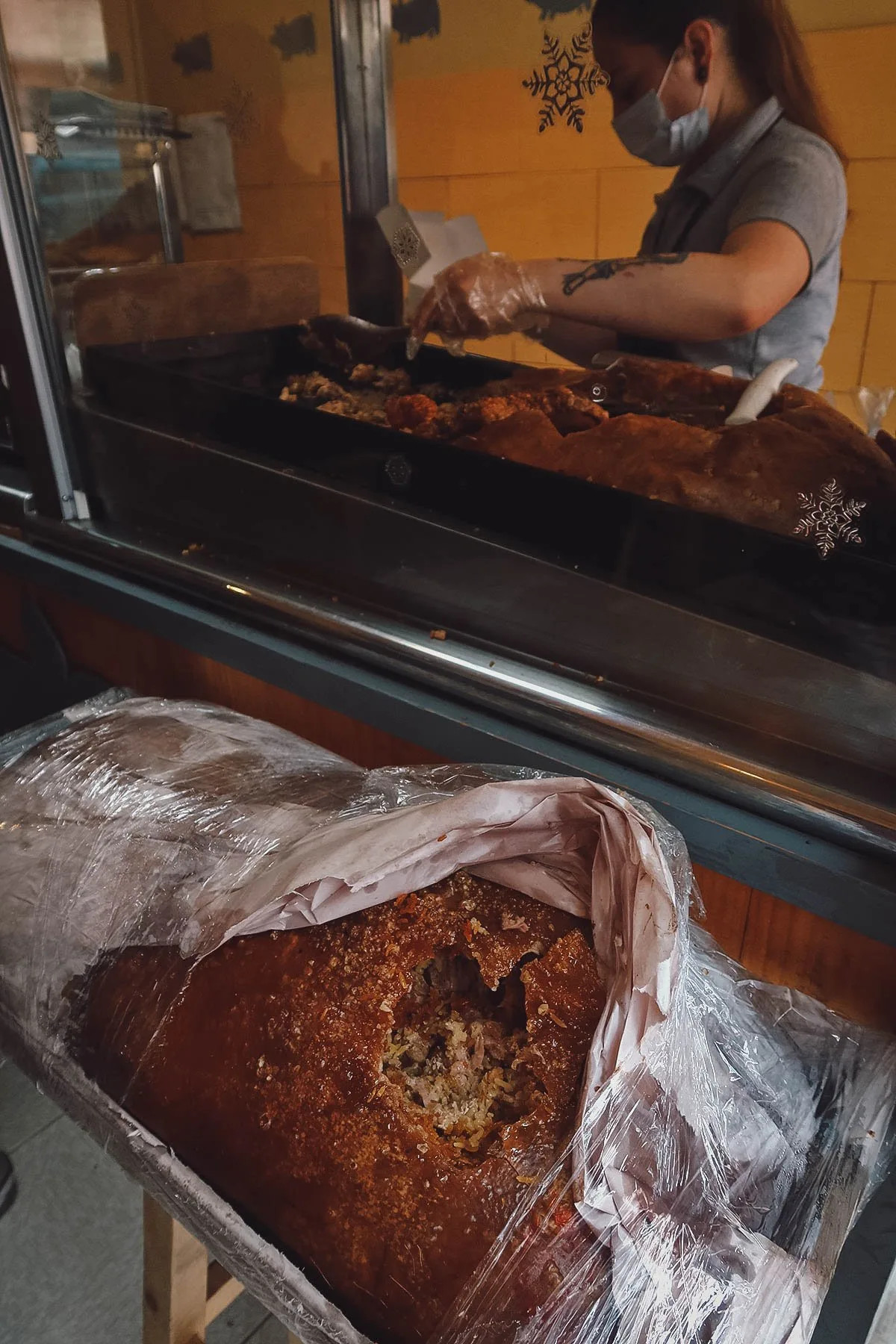 Colombian lechona, showcasing a section of roasted pig with crispy skin, filled with rice and pork, a traditional and festive dish.
Colombian lechona, showcasing a section of roasted pig with crispy skin, filled with rice and pork, a traditional and festive dish.
During a Bogota food tour, we visited a spot specializing solely in lechona. As someone familiar with Filipino lechon, I can attest to the Colombian version’s deliciousness, especially when paired with vinegar.
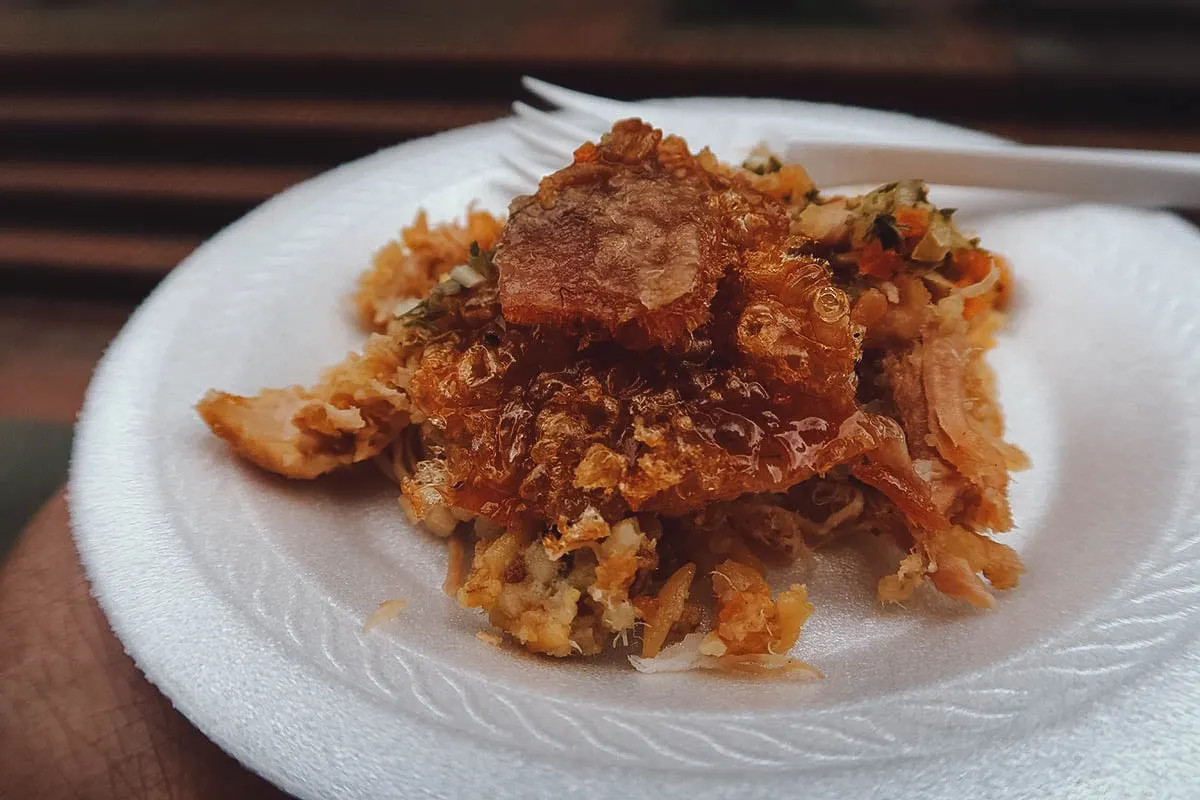 A plate of Colombian lechona, highlighting the tender pork and flavorful rice stuffing, served with crispy skin, a beloved Colombian specialty.
A plate of Colombian lechona, highlighting the tender pork and flavorful rice stuffing, served with crispy skin, a beloved Colombian specialty.
13. Cocteles: Seafood Street Food Surprise
Cocteles, Colombian seafood cocktails, were an unexpected street food highlight. Their incredible flavor was a delightful surprise.
Made with various seafood like shrimp, crab, octopus, squid, clams, and sea snails, cocteles are dressed in a cocktail sauce of ketchup, hot sauce, mayonnaise, lime juice, onions, and cilantro. Coctel de camarones (shrimp cocktail) is most common.
Served in styrofoam cups with saltine crackers, these Cartagena street food delights are surprisingly delicious and quickly became a personal favorite.
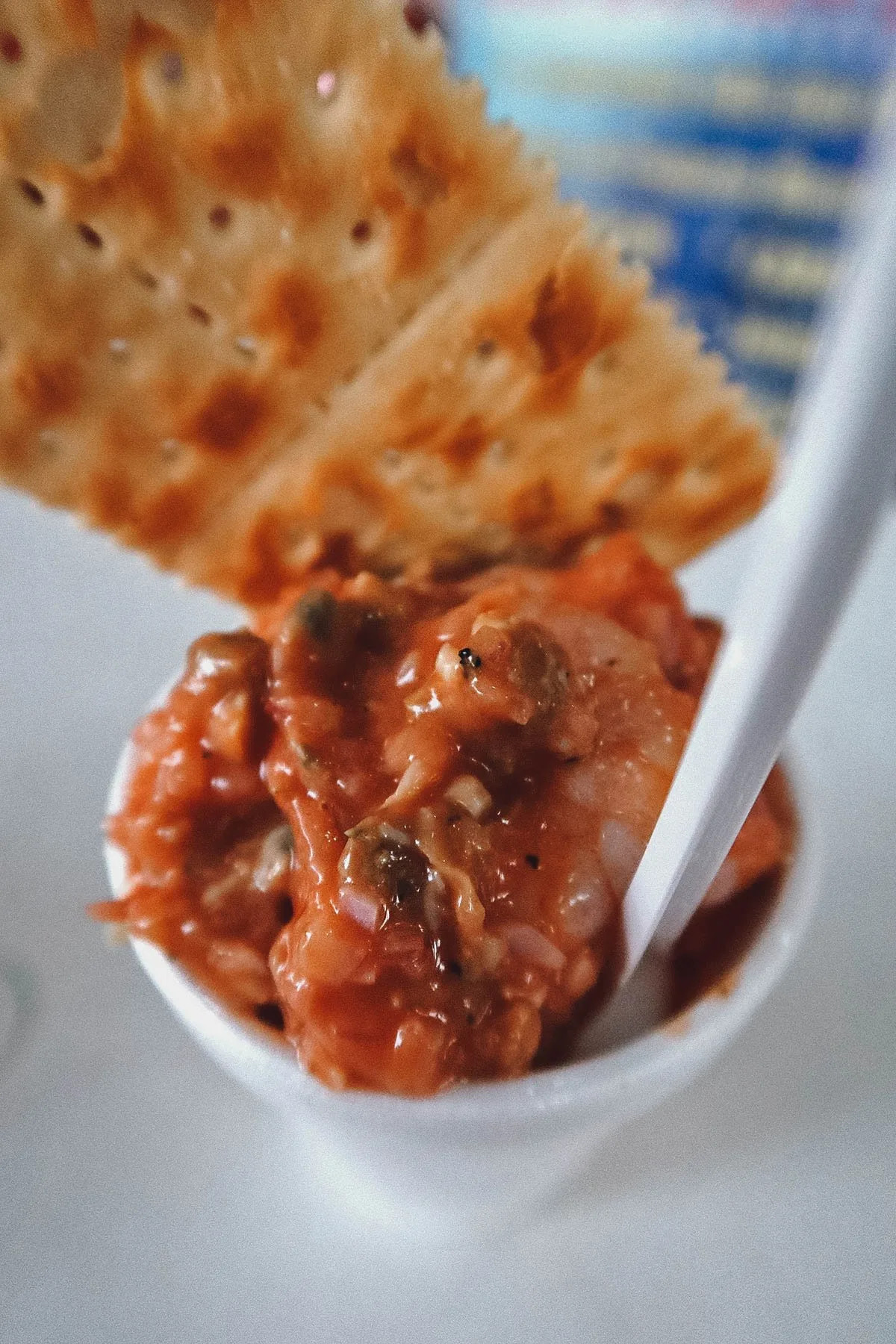 Colombian cocteles, featuring a seafood cocktail in a styrofoam cup, showcasing shrimp and other seafood in a pink cocktail sauce, a refreshing street food.
Colombian cocteles, featuring a seafood cocktail in a styrofoam cup, showcasing shrimp and other seafood in a pink cocktail sauce, a refreshing street food.
14. Patacones: Double-Fried Plantain Perfection
Like arepas, patacones are a staple side dish in Colombian cuisine. These flattened, double-fried unripe plantain discs are also popular street food items.
This patacon, topped with chicharron (fried pork belly) and white cheese, was quite filling. For a more substantial meal, order a patacon con todo, loaded with toppings like shoestring potatoes, sausages, chicharron, shredded chicken, cheese, and a fried egg.
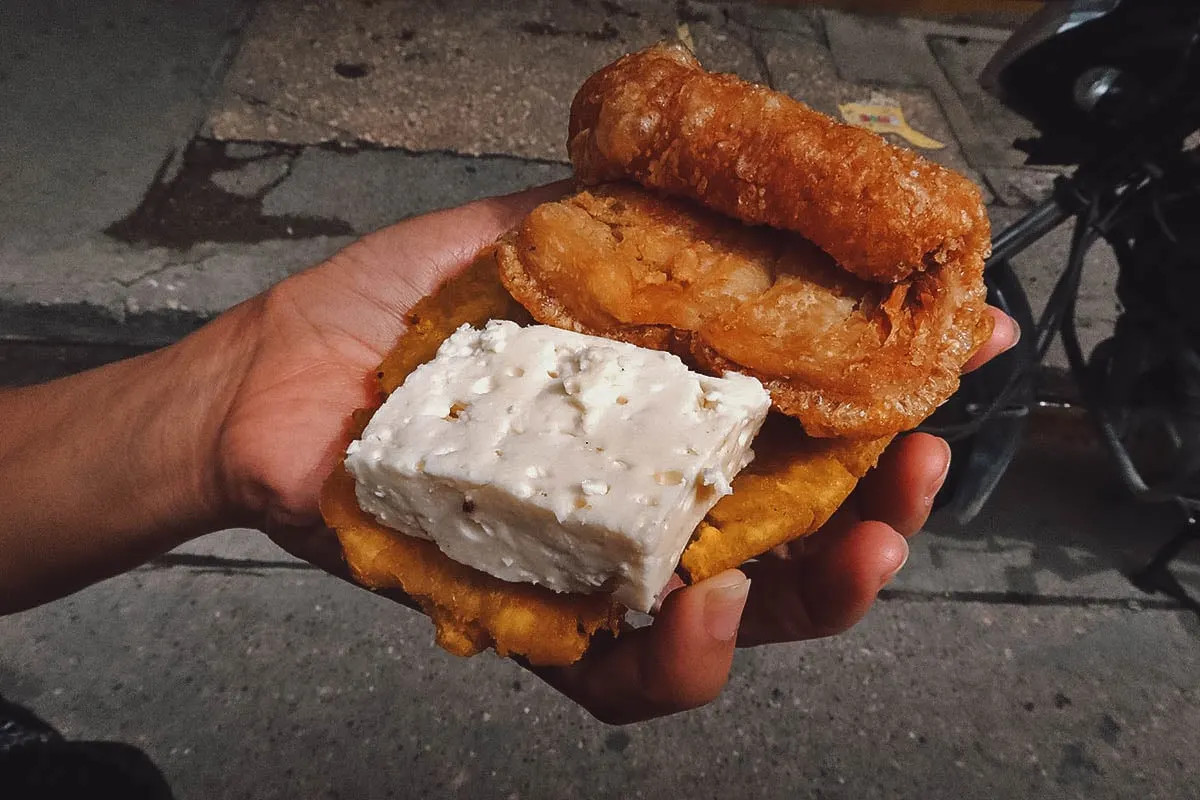 Colombian patacones, a large, flattened plantain topped with chicharron and white cheese, a savory and satisfying street food option.
Colombian patacones, a large, flattened plantain topped with chicharron and white cheese, a savory and satisfying street food option.
15. Hormigas Culonas: Adventurous Ant Snack
This Colombian street food is for the adventurous palate. Hormigas culonas, literally “big-assed ants,” are large leaf-cutter ants (Atta laevigata) consumed for centuries by the Guane indigenous people of Santander Department.
Harvested during a nine-week rainy season, reportedly only the queen ants are collected due to their large, consumable abdomens.
These ants are considered aphrodisiacs and traditionally given as wedding gifts.
 Colombian hormigas culonas, a close-up of large roasted ants, a unique and adventurous street food snack from the Santander region of Colombia.
Colombian hormigas culonas, a close-up of large roasted ants, a unique and adventurous street food snack from the Santander region of Colombia.
Their size is initially surprising – they appear too large to be ants.
Hormigas culonas are toasted or fried. We tried one version, possibly toasted, which was unexpectedly delicious. They offer a crunchy, nutty, almost chocolatey flavor and are considered nutritious, pairing well with cold beer. Highly addictive!
For daring foodies, hormigas culonas are a must-try unique Colombian street food.
 A handful of Colombian hormigas culonas, showcasing their roasted and crunchy texture, a novel and surprisingly tasty street food snack.
A handful of Colombian hormigas culonas, showcasing their roasted and crunchy texture, a novel and surprisingly tasty street food snack.
16. Perros Calientes: Colombian Hot Dog Extravaganza
Colombian hot dogs, perros calientes, are Medellín street food favorites, distinct from any hot dog you’ve likely encountered.
The difference lies in the toppings. Instead of typical ketchup, mustard, and relish, perros calientes are adorned with unconventional ingredients like ceviche, crab, shrimp in coconut sauce, refried beans, arugula, crushed potato chips, and shoestring potatoes.
After a night out in Medellín, a perro caliente is the ultimate satisfying craving-curber.
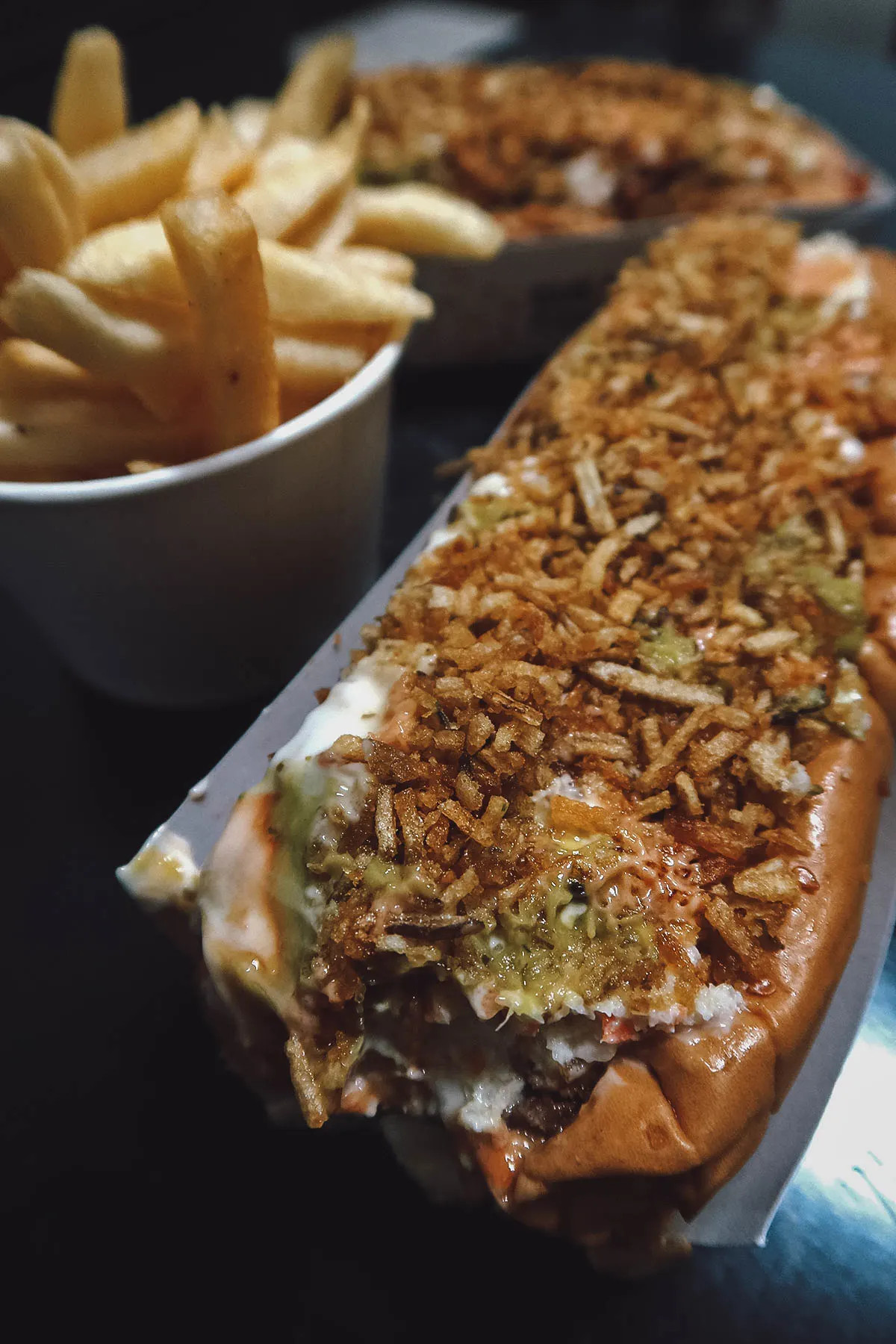 Colombian perro caliente, a loaded hot dog topped with a variety of sauces, shredded cheese, and potato sticks, showcasing the Colombian twist on a classic.
Colombian perro caliente, a loaded hot dog topped with a variety of sauces, shredded cheese, and potato sticks, showcasing the Colombian twist on a classic.
17. Mango Biche: Tangy Green Mango Snack
Colombia’s abundance of tropical fruits is evident on every street. Vendors in Cartagena and Medellín sell fresh fruits like passion fruit, lulo, guava, and soursop. On a Bogota food tour, we even sampled exotic fruits with unforgettable flavors.
While fruit juices are common, I prefer sliced fruit. Mango biche, a Cartagena street food favorite, features slices of unripe green mango seasoned with lime juice and salt – a perfect sweet and sour treat.
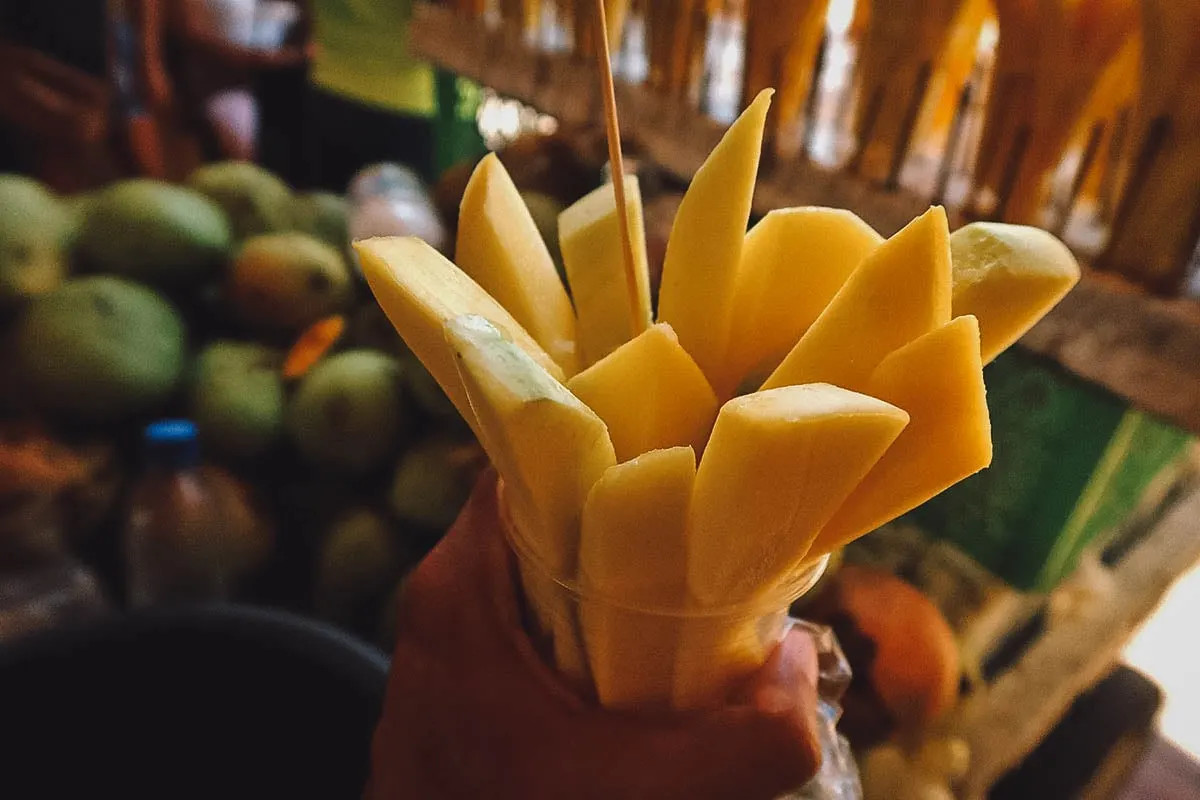 Colombian mango biche, slices of green mango seasoned with lime and salt, displayed in a clear bag, a refreshing and tangy street food snack.
Colombian mango biche, slices of green mango seasoned with lime and salt, displayed in a clear bag, a refreshing and tangy street food snack.
18. Cocada: Sweet Coconut Candy
Cocada, a traditional candy of shredded coconut and sugar, was a top Colombian street food for me. Variations exist across Central and South America, and even in the Philippines as bukayo.
Most popular in Cartagena, cocada vendors line Plaza de los Coches, offering various dulces tipicos (typical sweets). I indulged in cocada daily during our Cartagena stay, a nostalgic treat.
 Colombian cocada, squares of sweet coconut candy in various colors, a popular traditional sweet treat found throughout Colombia.
Colombian cocada, squares of sweet coconut candy in various colors, a popular traditional sweet treat found throughout Colombia.
19. Bocadillo: Guava Bite of Sweetness
If cocada was my favorite Colombian candy, bocadillo was a close second. Found in Colombia, Venezuela, Costa Rica, and Panama, bocadillo is made from guava pulp and panela (unrefined cane sugar), condensed into a bite-sized snack.
In Colombia, bocadillo is often paired with salty white cheese. This version combined with arequipe creates a highly addictive Colombian treat.
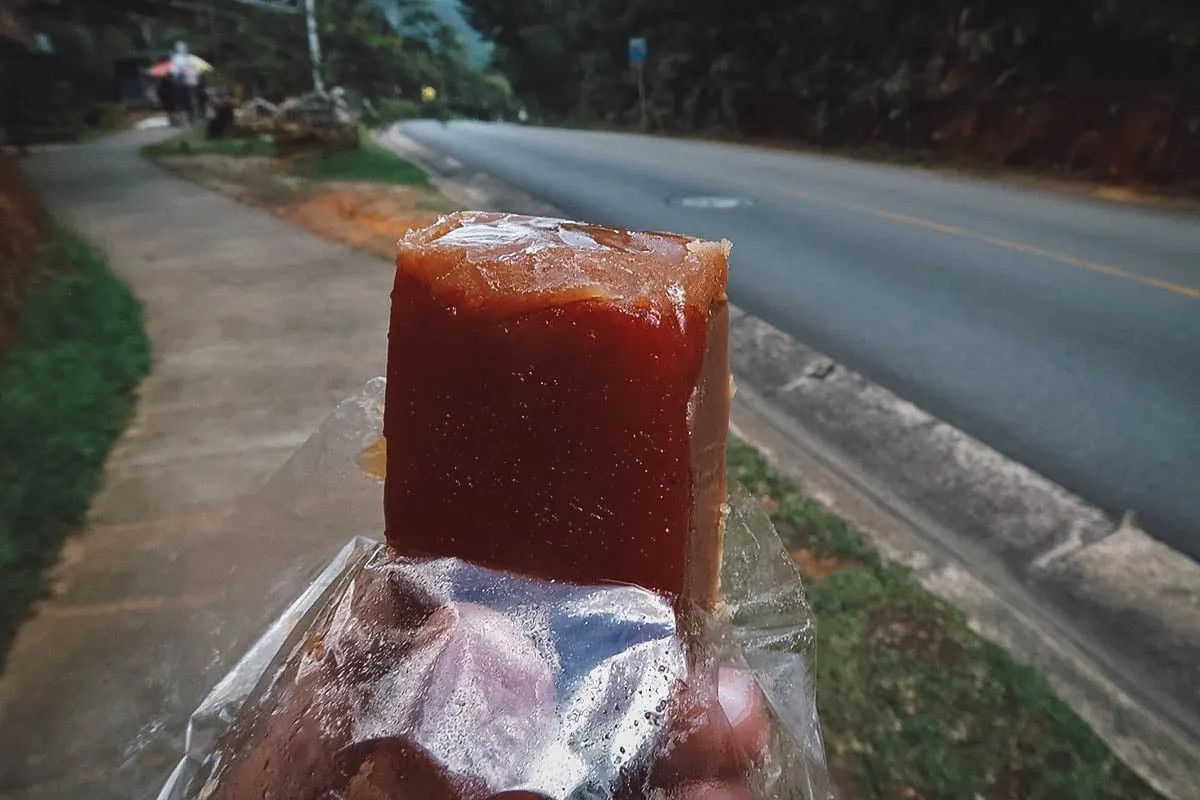 Colombian bocadillo, showcasing squares of guava paste candy, often paired with cheese, a simple yet flavorful sweet treat.
Colombian bocadillo, showcasing squares of guava paste candy, often paired with cheese, a simple yet flavorful sweet treat.
20. Brevas con Arequipe: Figs and Dulce de Leche
Dishes like brevas con arequipe highlight the value of food tours, introducing us to unique local flavors we might otherwise miss.
Brevas con arequipe is a traditional Colombian snack of cooked figs stuffed with dulce de leche. This sweet, creamy, fruity, and slightly bitter combination was irresistible.
We discovered brevas con arequipe among other street food snacks on our Bogota food tour.
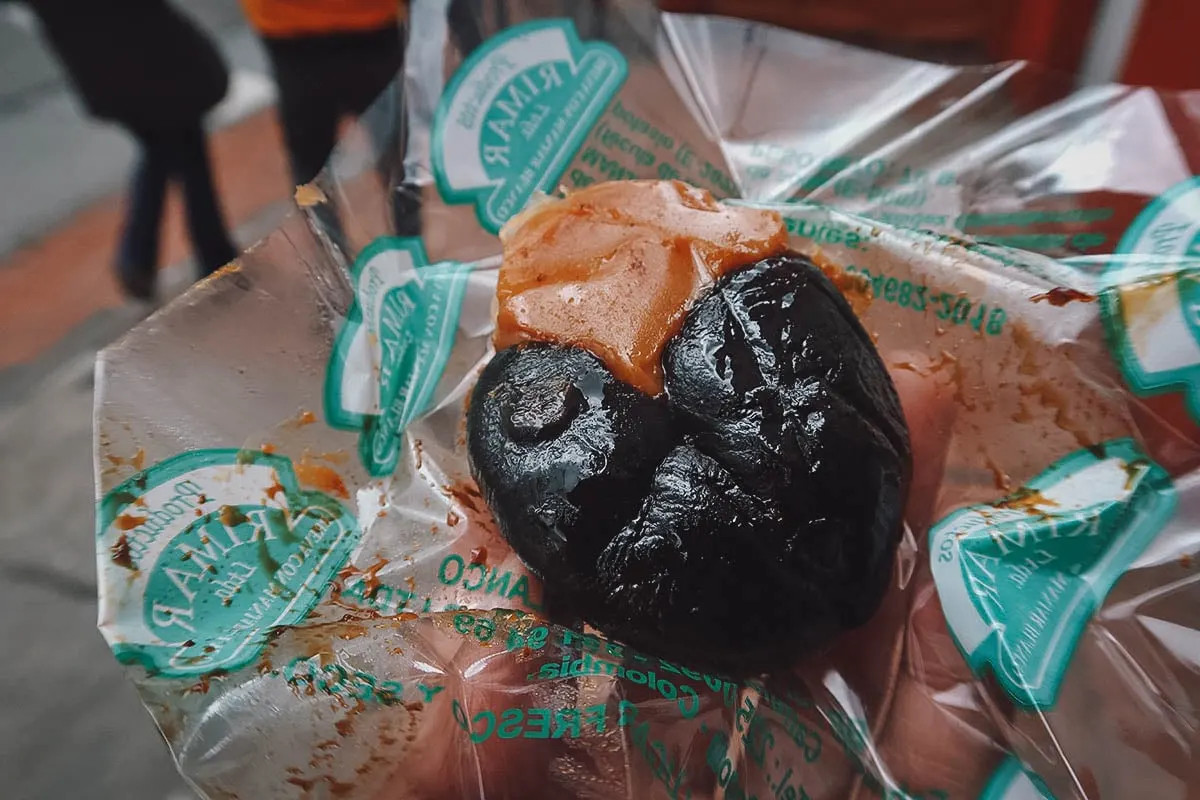 Colombian brevas con arequipe, cooked figs filled with dulce de leche, a traditional and sweet Colombian snack.
Colombian brevas con arequipe, cooked figs filled with dulce de leche, a traditional and sweet Colombian snack.
21. Cremas: Fruity Ice Pops
Visiting Comuna 13 in Medellín, I learned that cremas, fruity ice cream popsicles, are a local tradition. Embracing tradition, I tried a refreshing crema before leaving.
Made with various fruits, I recommend the mango biche crema, drizzled with lime juice and containing frozen green mango chunks.
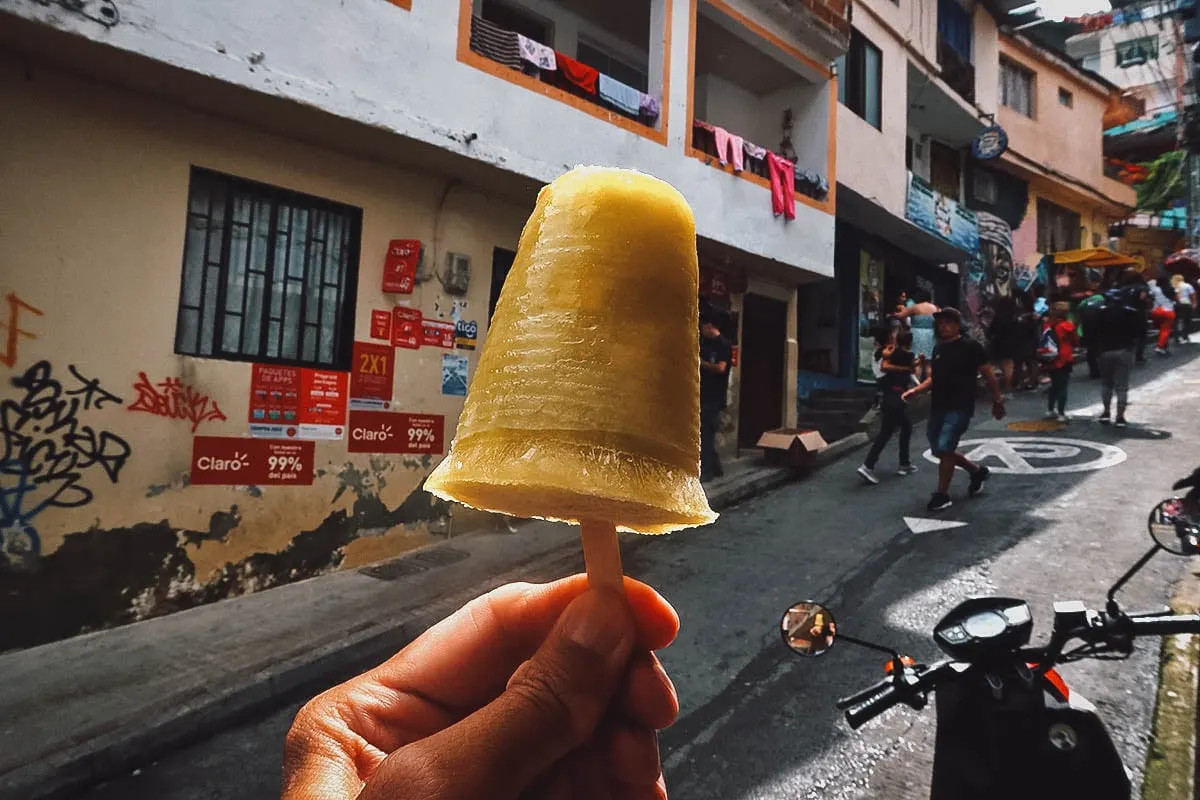 Colombian cremas, colorful fruit popsicles, with a mango flavor highlighted, a refreshing and icy street food treat.
Colombian cremas, colorful fruit popsicles, with a mango flavor highlighted, a refreshing and icy street food treat.
22. Guarapo: Sugarcane Juice Refreshment
In Vietnam, nuoc mia (sugarcane juice) is my go-to drink.
Fresh sugarcane juice is popular globally, including Brazil, Indonesia, Egypt, India, and Pakistan. In Colombia, it’s called guarapo.
This incredibly refreshing drink is a lifesaver on a hot Colombian day. Some vendors add lime, but I prefer it pure.
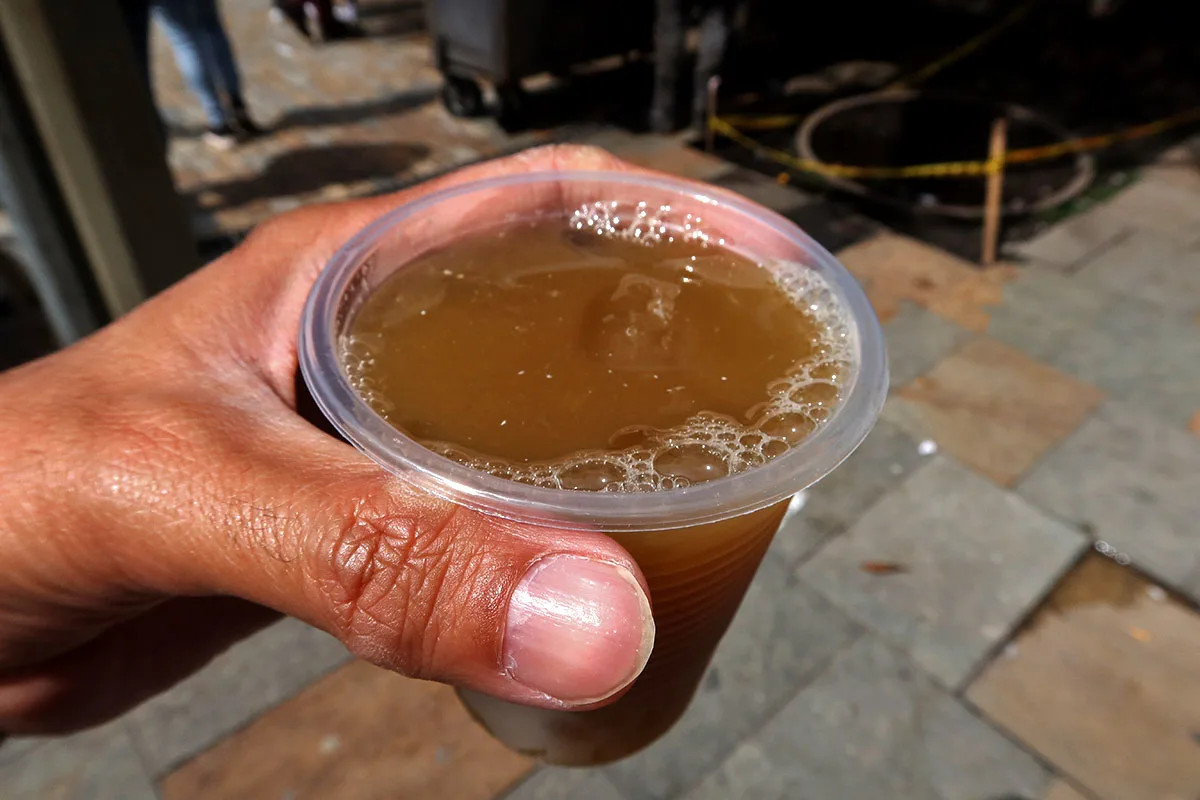 Colombian guarapo, freshly pressed sugarcane juice served in a clear cup with ice, a naturally sweet and refreshing drink.
Colombian guarapo, freshly pressed sugarcane juice served in a clear cup with ice, a naturally sweet and refreshing drink.
23. Chicha: Traditional Andean Drink
Like lechona tolimense and brevas con arequipe, we enjoyed chicha on our Bogota food tour.
Chicha, a traditional Andean and Amazonian drink, is common across Central and South America. Fermented or non-fermented, it’s traditionally corn-based, but can use other ingredients.
Colombian chicha is traditionally made from cooked corn and sugar, fermented for six to eight days, reminiscent of Mexican pulque.
 Colombian chicha, a creamy, light-colored drink in a glass, traditionally made from fermented corn, a unique and cultural beverage.
Colombian chicha, a creamy, light-colored drink in a glass, traditionally made from fermented corn, a unique and cultural beverage.
24. Canelazo: Warm Cinnamon Spice
Canelazo, a traditional hot Colombian drink, warmed us on Bogota’s chilly streets. It’s made with agua de panela, cinnamon, and aguardiente, an anise-flavored liqueur popular in Colombia.
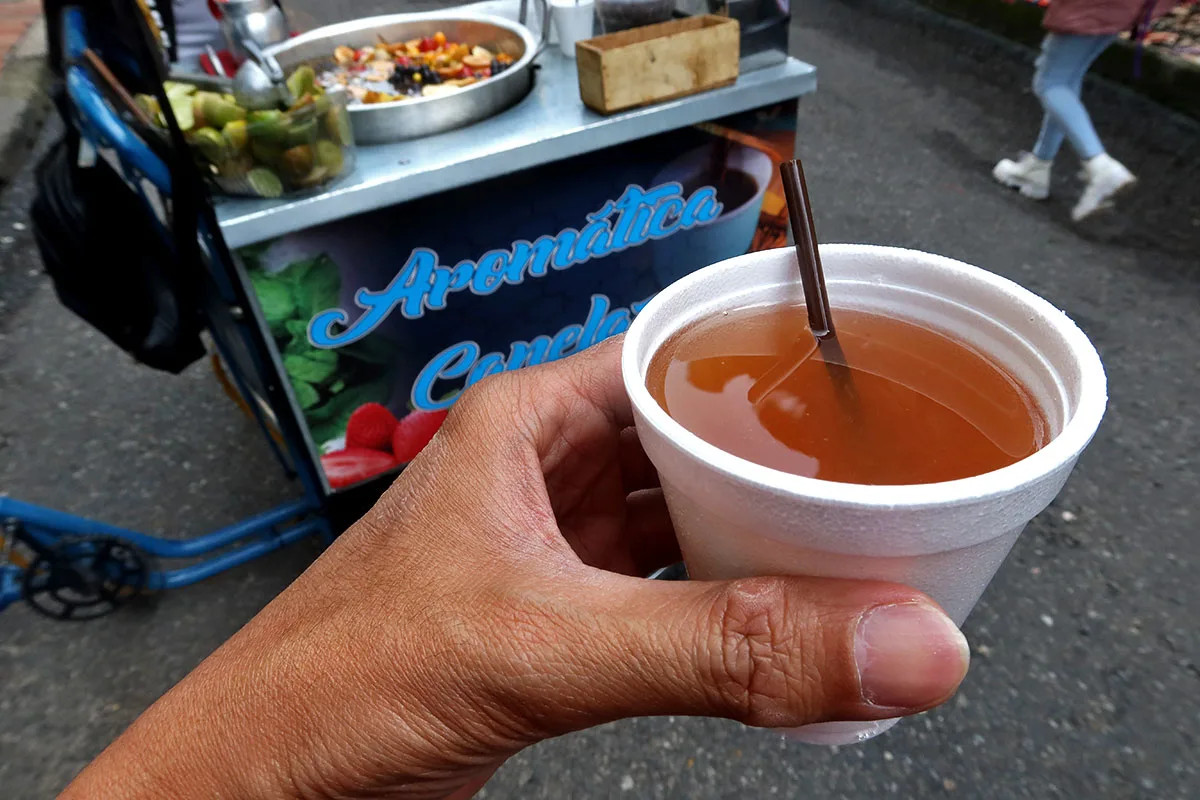 Colombian canelazo, a warm drink served in a clear glass, with visible steam and cinnamon sticks, a comforting and spiced beverage.
Colombian canelazo, a warm drink served in a clear glass, with visible steam and cinnamon sticks, a comforting and spiced beverage.
Traditional canelazo recipes often include just cinnamon, agua de panela, and aguardiente. However, this vendor’s version included fruits and spices, with liquor options available.
Canelazo is a delicious way to warm up on a cold Bogota day.
 Colombian canelazo, a close-up of the warm drink in a clay pot, showing fruits and spices infused in the beverage, a spiced and fruity variation of canelazo.
Colombian canelazo, a close-up of the warm drink in a clay pot, showing fruits and spices infused in the beverage, a spiced and fruity variation of canelazo.
25. Colombian Coffee: World-Class Brew
Last but not least, Colombian coffee needs no introduction. Its reputation is well-deserved.
As a regular coffee drinker, Colombia made me rediscover coffee. Balanced, caramel-y, with perfect fruitiness and acidity, Colombian coffee is consistently delicious.
From Cartagena street baristas to Bogota artisanal coffee shops, every cup in Colombia was a delight.
 Colombian coffee, a cup of black coffee with crema, highlighting the rich and aromatic Colombian coffee experience.
Colombian coffee, a cup of black coffee with crema, highlighting the rich and aromatic Colombian coffee experience.
Immerse Yourself with Colombian Food Tours
Food tours are the best way to explore local cuisine. Knowledgeable locals guide you to the best spots, explaining dishes in detail.
We highly recommend the street food tour in Bogota led by Andres, a certified food historian.
Explore more food tours in Bogota and Colombia on Get Your Guide.
Final Thoughts on Exploring Colombian Street Foods
From the Andes to the Caribbean coast, Colombia’s biodiversity extends to its street food. After a month exploring, this culinary diversity was evident.
While traditional dishes like bandeja paisa, ajiaco, and cazuela de mariscos are must-tries, Colombian street foods like cocteles, arepas de huevo, and bocadillo are equally enjoyable.
Ready to embark on your Colombian food adventure?
Disclosure
This Colombian street food guide contains affiliate links. We may earn a small commission if you make a purchase, at no extra cost to you. We only recommend products and services we use and believe in. Your support helps us create more free travel and food guides. ¡Muchas gracias!
Share this article to help other travelers discover Colombian street food!
9 shares
